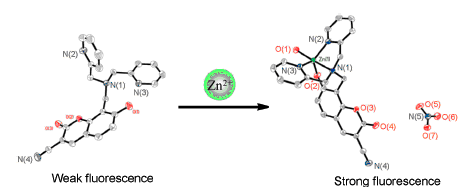| [1] Xu, Z. C.; Yoon, J.; Spring, D. R. Chem. Soc. Rev. 2010, 39, 1996.
[2] Prasad, A. S., Biochemistry of Zinc, Plenum Press, New York, 1993.
[3] Geiser, J.; Venken, K. J. T.; De Lisle, R. C.; Andrews, G. K. PLoS Genet. 2012, 8, e1002766.
[4] Thambiayya, K.; Wasserloos, K.; Kagan, V. E.; Stoyanovsky, D.; Pitt, B. R. Am. J. Physiol. 2012, 302, 1351.
[5] Maret, W.; Jacob, C.; Vallee, B. L.; Fischer, E. H. Proc. Natl. Acad. Sci. U. S. A. 1999, 96, 1936.
[6] (a)Nikseresht, S.; Etebary, S.; Karimian, M.; Nabavizadeh, F.; Zarrindast, M. R.; Sadeghipour, H. R. Arch. Iran. Med. 2012, 15, 306.
(b) Morris, D. R.; Levenson, C. W. J. Toxicol. 2012, 785647.
[7] Fraustoda Silva, J. J. R.; Williams, R. J. P. The Biological Chemistry of the Elements,Oxford University Press, Oxford, 1991, p. 561.
[8] Fischer Walker, C. L.; Lamberti, L.; Roth, D.; Black, R. E. Biomed. Health Res. 2011, 76, 234.
[9] Grabrucker, A. M.; Rowan, M.; Garner, C. C. Drug Delivery Lett. 2011, 1, 13.
[10] Gower-Winter, S. D.; Levenson, C. W. BioFactors 2012, 38, 186.
[11] Bicer, M.; Gunay, M.; Baltaci, A. K.; Uney, K.; Mogulkoc, R.; Akil, M. Br. Med. J. 2012, 113, 199.
[12] Chen, X.; Yu, H. N.; Shen, S. R.; Yin, J. J. J. Trace Elem. Med. Biol. 2007, 21, 125.
[13] (a) Srichaikul, B. Adv. Nat. Sci. 2012, 5, 1.
(b) Lee, J. Y.; Cho, E.; Seo, J. W.; Hwang, J. J.; Koh, J. Y. J. Neuropath. Exp. Neur. 2012, 71, 211.
[14] (a) Jayabharathi, J.; Thanikachalam, V.; Jayamoorthy, K. Spectrochim. Acta, Part A 2012, 95, 143.
(b) Liu, Z. P.; Zhang, C. L.; Chen, Y. C.; He, W. J.; Guo, Z. J. Chem. Commun. 2012, 48, 8365.
(c) Mandal, A. K.; He, T. C.; Maji, S. K.; Sun, H. D.; Zhao, Y. L. Chem. Commun. 2014, 50, 14378.
(d) Tang, L. J.; Zheng, Z. X.; Bian, Y. J. Chem. Online 2015, 78, 388 (in Chinese). (汤立军, 郑竹轩, 边延江, 化学通报, 2015, 78, 388.)
[15] (a) Tsien, R. W.; Tsien, R. Y. Rev. Cell Biol. 1990, 6, 715.
(b) Jitendra, B.; Umesh, F.; Banashree, B.; Simanpreet, K.; Narin- der, S.; Anupam, B.; Rajesh, D.; Ratnamala, B.; Anil, K. J. Mol. Recognit. 2015, 28, 369.
(c) Liu, M.; Tan, H. L.; Liu, Z. G.; Wang, W.; Zeng, W. B. Chin. J. Org. Chem. 2013, 33, 1655 (in Chinese). (刘敏, 谭慧龙, 刘治国, 王维, 曾文彬, 有机化学, 2013, 33, 1655.)
[16] (a) Priya, C.; Sivaramapanicker, S.; Ayyappanpillai, A. Chem. Asian J. 2007, 2, 338.
(b) Nolan, E. M.; Lippard, S. J. Acc. Chem. Res. 2009, 42, 193.
(c) Wong, B. A.; Friedle, S.; Lippard, S. J. J. Am. Chem. Soc. 2009, 131, 7142.
(d) Walkup, G. K.; Burdette, S. C.; Lippard, S. J.; Tsien, R. Y. J. Am. Chem. Soc. 2000, 122, 5644.
(e) Mizukami, S.; Okada, S.; Kimura, S.; Kikuchi, K. Inorg. Chem. 2009, 48, 7630.
(f) Song, Z. K.; Dong, B.; Lei, G. J.; Peng, M. J.; Guo, Y. Tetrahedron Lett. 2013, 54, 4945.
[17] (a) Domaille, D. W.; Zeng, L.; Chang, C. J. J. Am. Chem. Soc. 2010, 132, 1194.
(b) Yang, Z.; She, M. Y.; Yin, B.; Hao, L. K.; Obst, M.; Liu, P.; Li, J. L. Anal. Chim. Acta 2015, 868, 53.
(c) Fan, J. L.; Xu, Q. L.; Zhu, H.; Peng, X. J. Chin. J. Org. Chem. 2014, 34, 1623 (in Chinese). (樊江莉, 徐群利, 朱浩, 彭孝军, 有机化学, 2014, 34, 1623.)
[18] (a) Yuan, L.; Lin, W. Y.; Yang, Y. T.; Song, J. Z.; Wang, J. L. Org. Lett. 2011, 13, 3730.
(b) Jung, H. S.; Han, J. H.; Kim, Z. H.; Kang, C. H.; Kim, J. S. Org. Lett. 2011, 13, 5056.
(c) Perry, C. C.; Tang, V. J.; Konigsfeld, K. M.; Aguilera, J. A.; Milligan, J. R. J. Phys. Chem. B 2011, 115, 9889.
(d) Huo, F. J.; Sun, Y. Q.; Su, J.; Chao, J. B.; Zhi, H. J.; Yin, C. X. Org. Lett. 2009, 11, 4918.
(e) Peng, M. J.; Yang, X. F; Yin, B; Guo, Y.; Suzenet, F.; En, D.; Li, J.; Li, C. W.; Duan, Y. W. Chem. Asian J. 2014, 9, 1817.
[19] (a) Ciesienski, K. L.; Hyman, L. M.; Derisavifard, S.; Franz, K. J. Inorg. Chem. 2010, 49, 6808.
(b) Park, J. E.; Choi, M. G.; Chang, S. K. Inorg. Chem. 2012, 51, 2880.
(c) Ezeh, V. C.; Harrop, T. C. Inorg. Chem. 2012, 51, 1213.
(d) En, D.; Guo, Y.; Chen, B. T.; Dong, B.; Peng, M. J. RSC Adv. 2014, 4, 248.
(e) Hong, T.; Song, H. L.; Li, X.; Zhang, W. B.; Xie, Y. S. RSC Adv. 2014, 4, 6133.
[20] (a) Wu, J. S.; Sheng, R. L.; Liu, W. M.; Wang, P. F.; Ma, J. J.; Zhang, H. Y.; Zhuang, X. Q. Inorg. Chem. 2011, 50, 6543.
(b) Yuan, L.; Lin, W. Y.; Xie, Y. N.; Chen, B.; Zhu, S. J. Am. Chem. Soc. 2012, 134, 1305.
(c) Zhou, Y.; Liu, K.; Li, J. Y.; Fang, Y.; Zhao, T. C.; Yao, C. Org. Lett. 2011, 13, 1290.
(d) Choi, M. G.; Hwang, J. Y.; Moon, J. O.; Sung, J. Y.; Chang, S. K. Org. Lett. 2011, 13, 5260.
(e) Reddie, K. G.; Humphries, W. H.; Bain, C. P.; Payne, C. K.; Kemp, M. L.; Murthy, N. Org. Lett. 2012, 14, 680.
[21] (a) Runge, E.; Gross, E. K. U. Phys. Rev. Lett. 1984, 52, 997.
(b) Dreuw, A.; Head-Gordon, M. Chem. Rev. 2005, 105, 4009.
(c) Becke, A. D. J. Chem. Phys. 1993, 98, 5648.
(d) Lee, C.; Yang, W.; Parr, R. G. Phys. Rev. B 1988, 37, 785. |
